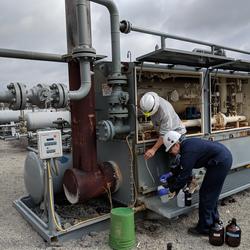Traditional, Renewable, and Emerging
We provide the Nation with publicly available assessments of diverse geologic energy resources.
We provide the Nation with publicly available assessments of diverse geologic energy resources.
Energy Waste Science
We supply science about the wastes produced during energy production and ways of repurposing them.
We supply science about the wastes produced during energy production and ways of repurposing them.
The Energy-Water Nexus
We inform decisions at the intersection of water and energy resource development.
We inform decisions at the intersection of water and energy resource development.
Energy Security and the Low-Carbon Transition
We deliver science needed to plan a secure and low-carbon energy economy.
We deliver science needed to plan a secure and low-carbon energy economy.
Energy Resources Program
From transportation to electricity, energy resources are critical to keep the Nation running. We provide actionable science and tools to support decision-making related to all aspects of the energy resource lifecycle.
News
Traversing the Sea for Science: How USGS Uses the Federal Fleet to Study Natural Hazards, Resources, and More
Traversing the Sea for Science: How USGS Uses the Federal Fleet to Study Natural Hazards, Resources, and More
USGS makes $10 million available for state geologic, geochemical mapping projects through Bipartisan Infrastructure Law-Funded Earth Mapping Resources Initiative
USGS makes $10 million available for state geologic, geochemical mapping projects through Bipartisan Infrastructure Law-Funded Earth Mapping Resources Initiative
USGS Releases Estimate of Conventional Oil and Gas Resources in North Chukchi Basin
USGS Releases Estimate of Conventional Oil and Gas Resources in North Chukchi Basin
Publications
Assessment of undiscovered conventional oil and gas resources in the Norphlet Formation, U.S. Gulf Coast region, 2023
Using a geology-based assessment methodology, the U.S. Geological Survey (USGS) estimated undiscovered, technically recoverable mean resources of 16 million barrels of oil and 348 billion cubic feet of gas in conventional reservoirs of the Norphlet Formation in the U.S. Gulf Coast region.
Mitigating climate change by abating coal mine methane: A critical review of status and opportunities
Methane has a short atmospheric lifetime compared to carbon dioxide (CO2), ∼decade versus ∼centuries, but it has a much higher global warming potential (GWP), highlighting how reducing methane emissions can slow the rate of climate change. When considering the contribution of greenhouse gas (GHG) emissions to current global warming (2010–2019) relative to the industrial revolution (1850–1900) leve
Produced water geochemistry from hydraulically stimulated Niobrara Formation petroleum wells: Origin of salinity and temporal perspectives on treatment and reuse
Produced water (i.e., a mixture of returned injection fluids and geologic formation brines) represents the largest volumetric waste stream associated with petroleum production in the United States. As such, produced water has been the focus of intense study with emphasis on understanding the geologic origin of the fluids, environmental impacts of unintended or intentional release, disposal concern
Science
Energy Waste Science
Energy production doesn’t just produce energy. We study the wastes produced from energy development to mitigate environmental impacts and explore ways of effectively repurposing them.
The Energy-Water Nexus
Water is a requirement for life. We study the intersection of water and energy resources to support resource management decisions.
Evolving Utilization of Solid Energy Fuels (EUSEF)
Although the traditional use of solid fuels such as coal for electric power generation in the U.S. has declined, other uses for solid fuels and their byproducts are rapidly evolving. Internationally, construction of new generation facilities to provide electricity to previously underserved areas has kept worldwide coal demand steady. The Evolving Utilization of Solid Energy Fuels (EUSEF) project...






